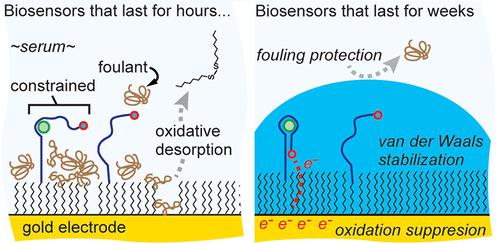Our official English website, www.x-mol.net, welcomes your
feedback! (Note: you will need to create a separate account there.)
Week-Long Operation of Electrochemical Aptamer Sensors: New Insights into Self-Assembled Monolayer Degradation Mechanisms and Solutions for Stability in Serum at Body Temperature
ACS Sensors ( IF 8.2 ) Pub Date : 2023-03-08 , DOI: 10.1021/acssensors.2c02403 Zach Watkins 1, 2 , Aleksandar Karajic 3 , Thomas Young 1 , Ryan White 3, 4 , Jason Heikenfeld 1, 3
ACS Sensors ( IF 8.2 ) Pub Date : 2023-03-08 , DOI: 10.1021/acssensors.2c02403 Zach Watkins 1, 2 , Aleksandar Karajic 3 , Thomas Young 1 , Ryan White 3, 4 , Jason Heikenfeld 1, 3
Affiliation

|
Conventional wisdom suggests that widely utilized self-assembled alkylthiolate monolayers on gold are too unstable to last more than several days when exposed to complex fluids such as raw serum at body temperature. Demonstrated here is that these monolayers can not only last at least 1 week under such harsh conditions but that significant applied value can be captured for continuous electrochemical aptamer biosensors. Electrochemical aptamer biosensors provide an ideal tool to investigate monolayer degradation, as aptamer sensors require a tightly packed monolayer to preserve sensor signal vs background current and readily reveal fouling by albumin and other solutes when operating in biofluids. Week-long operation in serum at 37 °C is achieved by (1) increasing van der Waals interactions between adjacent monolayer molecules to increase the activation energy required for desorption, (2) optimizing electrochemical measurement to decrease both alkylthiolate oxidation and electric-field-induced desorption, and (3) mitigating fouling using protective zwitterionic membranes and zwitterion-based blocking layers with antifouling properties. This work further proposes origins and mechanisms of monolayer degradation in a logical stepwise manner that was previously unobservable over multiday time scales. Several of the observed results are surprising, revealing that short-term improvements to sensor longevity (i.e., hours) actually increase sensor degradation in the longer term (i.e., days). The results and underlying insights on mechanisms not only push forward fundamental understanding of stability for self-assembled monolayers but also demonstrate an important milestone for continuous electrochemical aptamer biosensors.
中文翻译:

电化学适体传感器的为期一周的运行:对自组装单层降解机制和体温血清稳定性解决方案的新见解
传统观点认为,广泛使用的金上自组装烷基硫醇盐单层太不稳定,当暴露于复杂液体(例如体温下的原始血清)时,无法持续超过几天。这里证明,这些单层不仅可以在如此恶劣的条件下持续至少 1 周,而且可以为连续电化学适体生物传感器捕获显着的应用价值。电化学适体生物传感器提供了研究单层降解的理想工具,因为适体传感器需要紧密堆积的单层来保持传感器信号与背景电流的关系,并在生物流体中操作时轻松揭示白蛋白和其他溶质的污染。通过 (1) 增加相邻单层分子之间的范德华相互作用以增加解吸所需的活化能,(2) 优化电化学测量以减少烷基硫醇氧化和电场,可以在 37 °C 的血清中进行为期一周的操作。诱导解吸,(3) 使用保护性两性离子膜和具有防污性能的基于两性离子的阻挡层减轻污染。这项工作进一步以逻辑逐步的方式提出了单层降解的起源和机制,这在以前在多天的时间尺度上是无法观察到的。一些观察到的结果令人惊讶,表明传感器寿命(即数小时)的短期改进实际上会增加传感器在长期(即数天)内的退化。这些结果和对机制的基本见解不仅推动了对自组装单层稳定性的基本理解,而且证明了连续电化学适体生物传感器的一个重要里程碑。
更新日期:2023-03-08
中文翻译:

电化学适体传感器的为期一周的运行:对自组装单层降解机制和体温血清稳定性解决方案的新见解
传统观点认为,广泛使用的金上自组装烷基硫醇盐单层太不稳定,当暴露于复杂液体(例如体温下的原始血清)时,无法持续超过几天。这里证明,这些单层不仅可以在如此恶劣的条件下持续至少 1 周,而且可以为连续电化学适体生物传感器捕获显着的应用价值。电化学适体生物传感器提供了研究单层降解的理想工具,因为适体传感器需要紧密堆积的单层来保持传感器信号与背景电流的关系,并在生物流体中操作时轻松揭示白蛋白和其他溶质的污染。通过 (1) 增加相邻单层分子之间的范德华相互作用以增加解吸所需的活化能,(2) 优化电化学测量以减少烷基硫醇氧化和电场,可以在 37 °C 的血清中进行为期一周的操作。诱导解吸,(3) 使用保护性两性离子膜和具有防污性能的基于两性离子的阻挡层减轻污染。这项工作进一步以逻辑逐步的方式提出了单层降解的起源和机制,这在以前在多天的时间尺度上是无法观察到的。一些观察到的结果令人惊讶,表明传感器寿命(即数小时)的短期改进实际上会增加传感器在长期(即数天)内的退化。这些结果和对机制的基本见解不仅推动了对自组装单层稳定性的基本理解,而且证明了连续电化学适体生物传感器的一个重要里程碑。











































 京公网安备 11010802027423号
京公网安备 11010802027423号